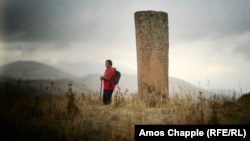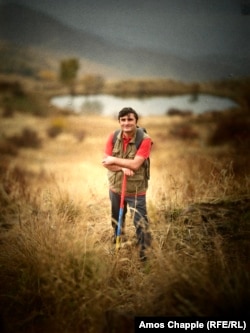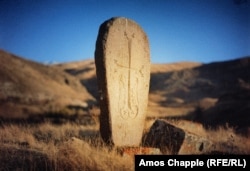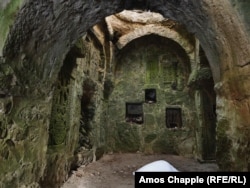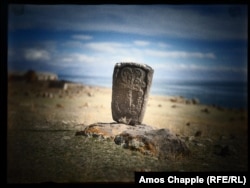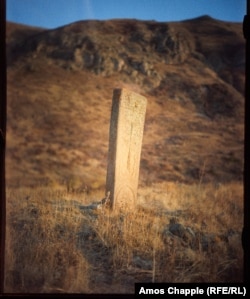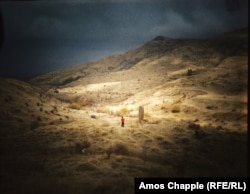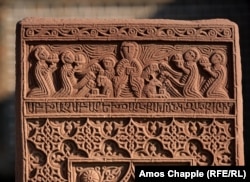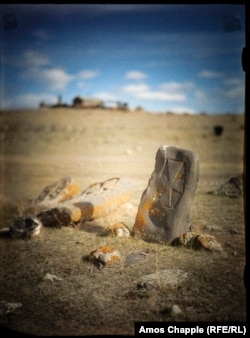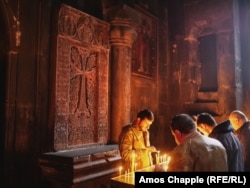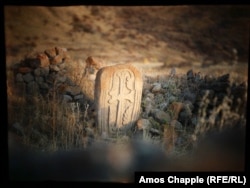Sevak Arevshatian has never stepped foot outside Armenia, but the history enthusiast knows every province of his homeland by heart.
From the lush forests of Lori in the north to rocky and barren Syunik in the south, the 33-year-old has hiked through all the regions of Armenia to find and document thousands of wild khachkars.
Khachkars, also known as cross-stones, are carved stone monuments deeply entwined with the national identity of Armenia. Artful khachkars first began appearing in the open in the late 800s as Arab rule over Armenian lands began to weaken.
Early cross-stones served in part to let passing travelers know they were on Christian land. Armenia was the first country in the world to officially adopt Christianity, in the year 301.
In 2015, Arevshatian launched a Facebook page called World Of Khachkars that has become one of the biggest online repositories of khachkar photographs. Many of the pictures were made by Arevshatian with his cell phone during sometimes days-long missions to uncover cross-stones, while others were uploaded by some of the thousands of khachkar enthusiasts who follow the page.
Many khachkars stand, famous and well-photographed, within the grounds of monasteries and the walls of churches. Others are far off the beaten track and known only to a few wandering shepherds and khachkar devotees such as Arevshatian. It is estimated there are tens of thousands of historic cross-stones scattered throughout Armenia, and no two are the same.
Arevshatian’s exposure to cross-stones began when he was a small boy watching his father -- a khachkar master carver -- chisel intricate details into slabs of red stone. But it was only later, when he returned from the army, that he fell in love with the tradition.
“Over time, I realized that the psychological impact of khachkars is enormous.… It soothes the restless person, dispels anxiety, and alleviates grief,” he says.
Khachkars have long been seen as the most “democratic” of Christian sites. Away from the pomp and ritual of the church, Armenian villagers could simply walk to a khachkar in the countryside to share their hopes or grief with the silent stone mediators.
The role of cross-stones as an intermediary with God is directly represented in a common design of the khachkar (seen in the Noratus stone photographed above) that features a disk at the bottom, which some believe represents the world, and various depictions of heaven or infinity at the top. In the center, a cross serves as the link between the two realms.
Arevshatian says the most exciting part of finding little-known khachkars is being able to identify the sometimes famed carvers who produced them.
“During my searches, I realized one of the carvers, Kiram, created more than 80 khachkars and tombstones, which is an absolute record among khachkar makers," he says.
Some khachkars are marked with the name of the artist. Historians believe such "signatures" indicate a degree of pride from those who commissioned the monument in being able to afford the greatest masters of the ancient stone art.
The reasons for khachkar emplacement can be highly varied. Many khachkars mark graves; others were commissioned to honor ground where a battle was won or to show where a holy vision was claimed to have taken place. Some mark the site where a village was founded.
After the most recent war with Azerbaijan, thousands of khachkars in the Nagorno-Karabakh region are once more under the control of Baku, leading to concerns about their preservation.
Through the early 2000s, around 10,000 khachkars in the ancient Armenian cemetery of Julfa were systematically destroyed, apparently by Azerbaijani soldiers.
But Arevshatian makes sure the bitter political discussions that plague much of Armenian social media are kept off the site that he manages. It remains an oasis for fans of the ancient stone monuments.
A note at the top of Arevshatian's Facebook page says: “Please do not post anything besides photos of Khachkars. I will not approve it.”
Editor's Note: Several photos in this story were shot using a large-format FKD camera made in the Ukrainian S.S.R. in 1972. The camera gives the images an increased sense of depth and, in some cases, visual imperfections.
